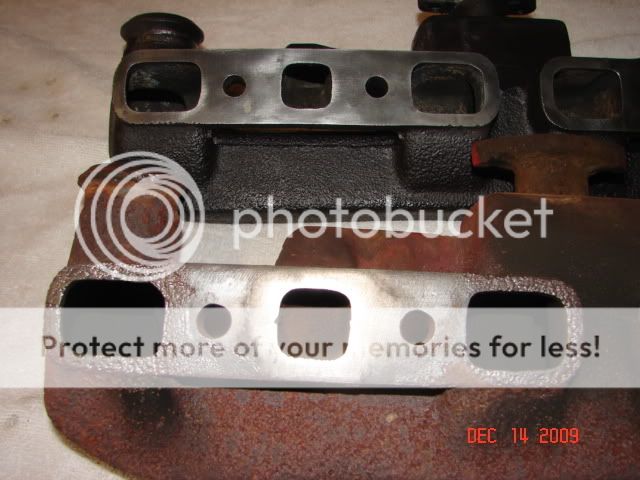Yea, I'd say it's time to fix that.
You can get your manifold resurfaced for about $30 -40 at most machine shops. If it is OEM & can be salvaged, do it.
I've got nice fitting new manifolds for $85.
The nuts are brass, 7/16-20 x 5/8, NAPA part number STN104X, 27 lbs of torque. Fastenal has them for about $1.50 each; part number 75133. OEM studs are 1-5/8 long 7/16-14. NAPA doesn’t stock the 5/8’s length, but part number RFD 86644, 1 ¾ inch, works as does part number 86632, 2 inches. These studs are “Handi-Pack” items. (I’ve used these longer studs on my 50 & 51 N’s, but you should make sure they do not bottom out in the block on your N as they are longer than OEM). If you don’t get them at NAPA, make sure that the stud has an egg-shaped center between the different threads. Use washers under the nuts.
If you're really lucky, you can get the nuts off w/o removing a stud or damaging it. And, if you buy a ticket, you could win the lottery. Drain the block & plan on at least one stud getting replaced!
There are two distinctly different recommendations on tightening the studs in the block. Because the stud goes into the water jacket & is constantly undergoing extreme heat & cooling cycles, some folks like to double-nut them & tighten them down at 37 lbs of torque. Others say that it’s a stud & should only be finger tight w/ a good dose of thread sealer or high temp silicone on them.
I’ve replaced the studs on 3 of my 4 N’s w/ no leaks; I finger tighten the studs then take a ¼ turn on them w/ vice grips.
This method of attaching the exhaust pipe to the manifold was developed for the Model A Ford in 1927. If you pay attention to what you are doing, it will not leak. You do not need tinfoil or gasket sealer to prevent leaks. Use the correct parts & install them correctly & it will not leak.
Make sure you are using the correct clamp. An automotive muffler c-clamp will not work. You need a clamp made for the N. If you have the correct clamp, it has a top & bottom. Make sure you have the clamp on correctly; check out tip # 8, below. All clamps are not created equally; the correct clamp should have 9/16 brass nuts.
Slide the tail pipe into the hanger clamp & then place the end of the exhaust pipe against the manifold. Look at it! Remember, the pipe will most always fit snugly to the OEM manifold w/o any problem, but a replacement manifold will likely not be the exact same size as the OEM manifold, so you will have some work to do. If it does not mate all the way around, put a broomstick down the pipe & into the manifold & gently bend the pipe until both surfaces mate snugly & squarely. If the exhaust pipe flange is bent, you will never get a good seal; check it out. The clamp is not a gasket; if the pipe & manifold do not mate tightly, it will leak. Do not try & hold the exhaust pipe against the manifold w/ your hand & while you tighten the clamp. Get out your floor jack & a block of wood; put the jack under the pipe to hold it tightly against the manifold. Confirm that the pipe is mated squarely to the manifold; if it is crooked, it will not seat. With the pipe jacked snugly and squarely to the manifold use your ¾ lb ball peen hammer and tap the pipe tight to the manifold flange all the way around. Its soft metal and this will only take about a minute. Tighten the clamp. (Don't get carried away w/ the jack or you will bend the pipe. Or, overtighten the clamp & snap it in two. BTDT). Put equal pressure on the clamp by tightening one side a few turns then a few turns on the other. Do not expect the clamp sides to touch; about 1/8” gap is normal.
When the clamp is tightened equally on both sides, remove the jack. If the pipe flops around, start over because you put the clamp on upside down. (Remember tip # 8)
If the block is badly pitted, (usually around # 4) you will have problems; get out the hi-temp metal epoxy. (Not JB Weld) VersaChem's exhaust manifold repair, or ThermoSteel, is said to be good to 2000 degrees. Clean the area real well with brake cleaner, put a little epoxy on it, put some wax paper over it and bolt down the manifold. After it dries take off the manifold and take a die grinder and clean the epoxy that might squish into the port. Look at the manifold, again around # 4. If it’s pitted & burned, it isn’t going to seal. Time to surface it or get a new one. Do not double the gaskets! The gasket has two pieces, left & right (or front & back.....whatever) Use hi-temp Permatex or even Copper coat. Make sure the surface is squeaky clean!
75 Tips



